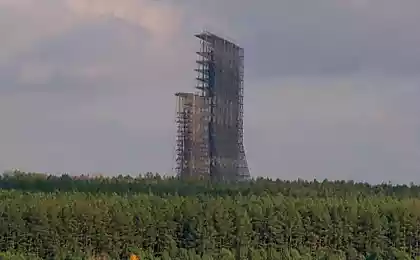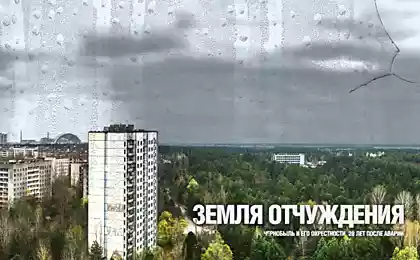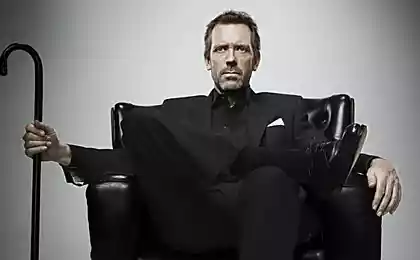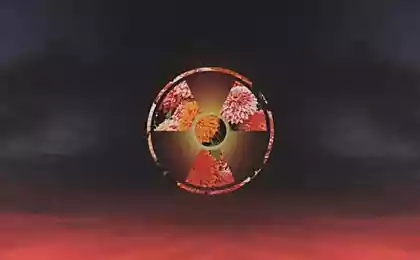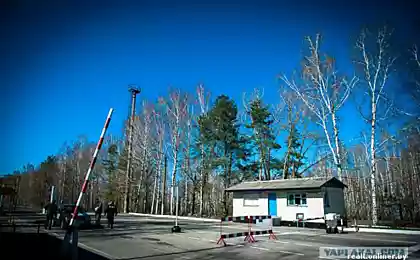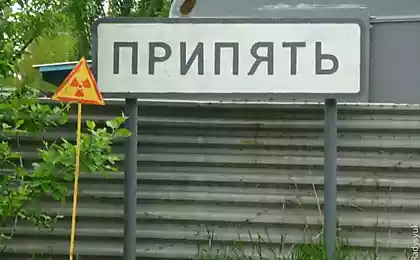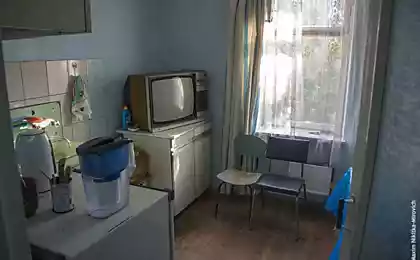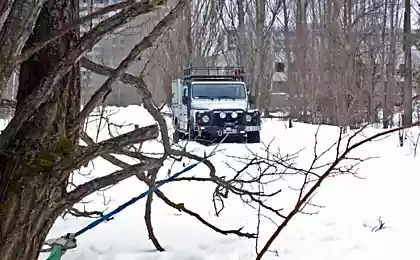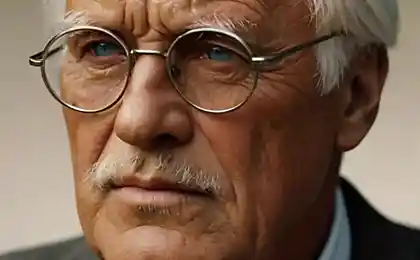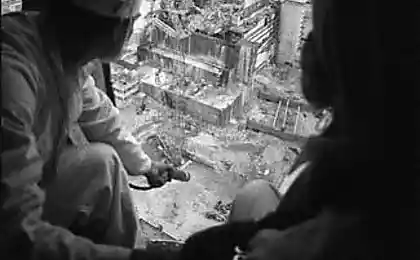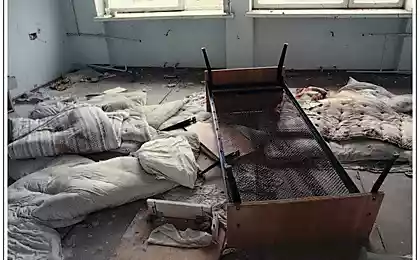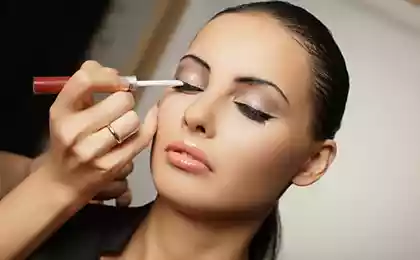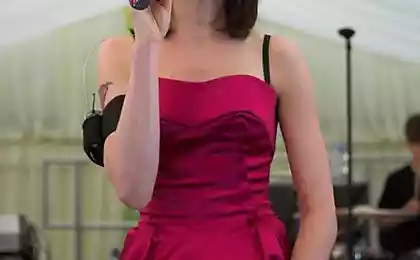5090
Shadow of Chernobyl
April 26, 2012 was the 26th anniversary of the accident at Unit 4 Chernobyl them. Lenin.
Offers a large selection of professional journalistic photos with comments on the subject accident and its posledstviy.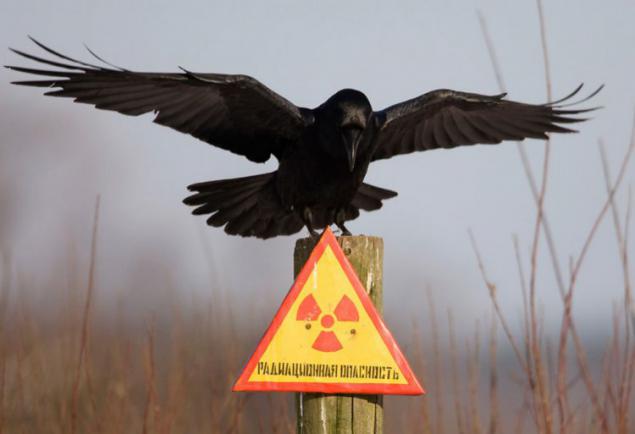
April 26, 1986 the operators in this very hall №4 reactor of the Chernobyl made a series of fatal errors during testing equipment, resulting in the world's largest happened at that time technological disaster. In the photo: an abandoned room of the 4th reactor of Chernobyl, 2005. (Gerd Ludwig / INSTITUTE)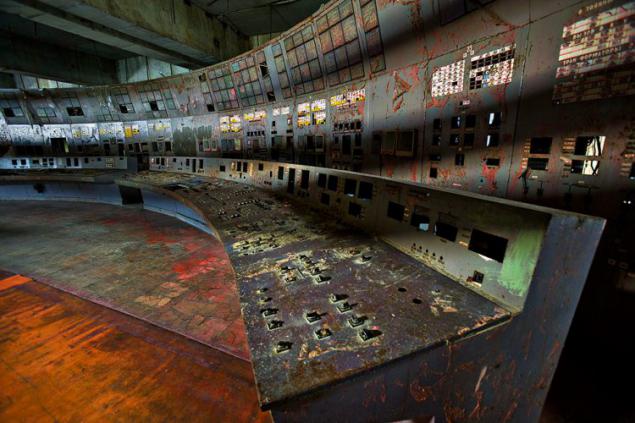
Workers in gas masks and respirators are going to drill holes for the support elements. This is a very dangerous job: the radiation level is so high that they constantly have to monitor the Geiger counters and dosimeters, and to be in this place it can be only 15 minutes a day. Chernobyl in 2005. (Gerd Ludwig / INSTITUTE)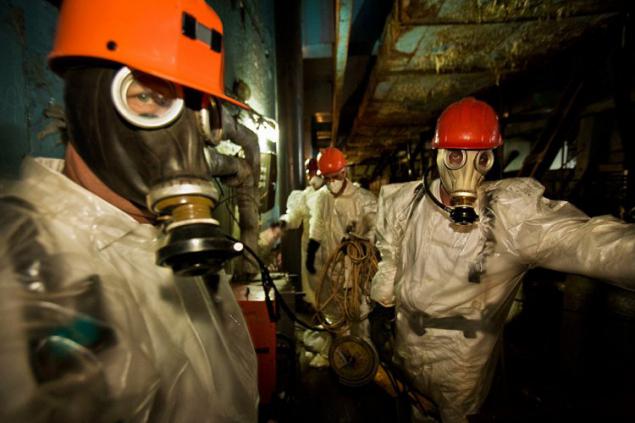
For years, people made desperate attempts to secure the roof seekers to not collapsed. In the dimly lit tunnels sarcophagus lead to terrible rooms, full of cables, metal and other materials. Walls collapsed and debris covered the radiation dust. Work on the stabilization of completed and today inside the reactor deserted and very high levels of radiation. He is waiting for dismantling. Chernobyl in 2011. (Gerd Ludwig / INSTITUTE)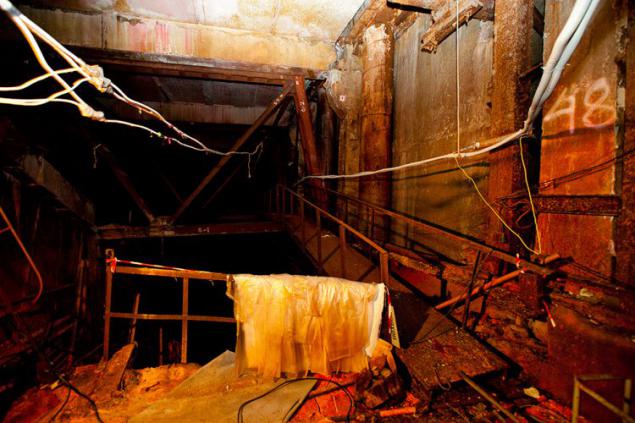
Although the level of radiation is not allowing you to stay longer than a few minutes, the workers have to overcome dangerous stairs to get to the molten core. For faster descent are built just such a "slanted ladder." (Gerd Ludwig / INSTITUTE)
Working near the nuclear power plant are exposed to dangerous levels of radiation. They are building a new Chernobyl sarcophagus worth 2, $ 2 billion. Arcuate metal structure weighing 29,000 tons height of 105 m and a width of 257 m will be built over the existing building to be able to demolish the old sarcophagus. To make a very strong foundation of a new sarcophagus in the ground 25 meters hammered 396 huge metal pipe. 2011. (Gerd Ludwig / INSTITUTE)
View from the roof of the hotel "Polesie" in the center of Pripyat. Once lived in Pripyat 50,000 people, and it is now - a ghost town, overgrown with lush vegetation. (Gerd Ludwig / INSTITUTE)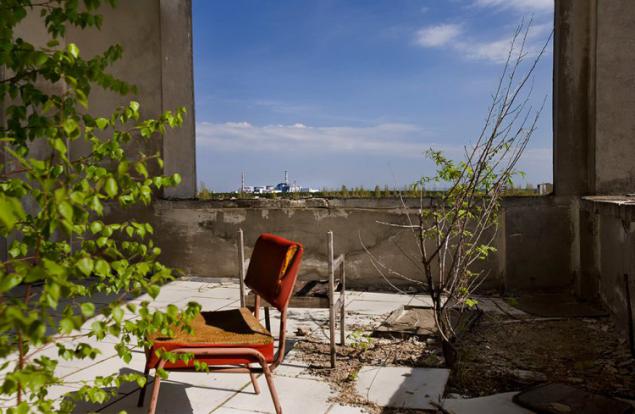
Built in 1970 for scientists and workers of the Chernobyl Nuclear Power Plant Pripyat is less than 3 km from the reactor. Once upon a time there lived 50,000 people. Authorities did not immediately warned residents about the disaster and began evacuating only 36 hours after the explosion. The picture in 1993. (Gerd Ludwig / INSTITUTE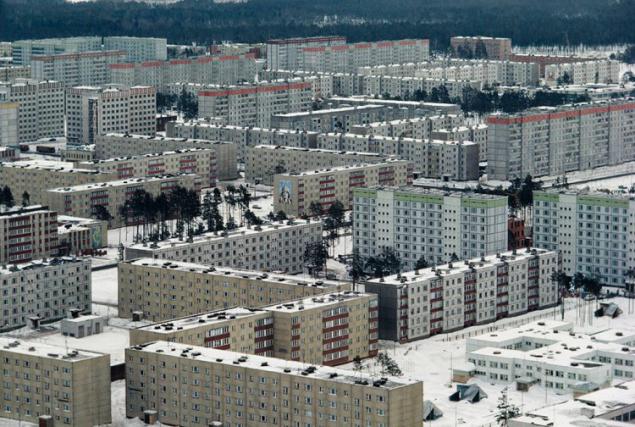
When the authorities finally ordered to evacuate, many simply do not have time to pack. The Soviet Union announced the crash just three days after the explosion, when the nuclear cloud reached Sweden. Photo: Opachichi village in the Exclusion Zone, 1993. (Gerd Ludwig / INSTITUTE)
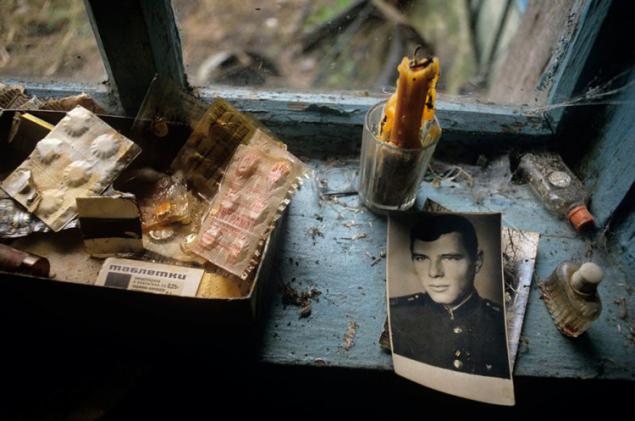
19 years after the disaster empty schools and kindergartens in Pripyat remain silent reminder of the sudden tragedy. This part of a school collapsed due to dilapidated. 2005. (Gerd Ludwig / INSTITUTE)

On the day of the disaster unsuspecting children playing in the room. The next day they were evacuated, and they had to leave everything, even the favorite dolls and toys. 2005. (Gerd Ludwig / INSTITUTE)
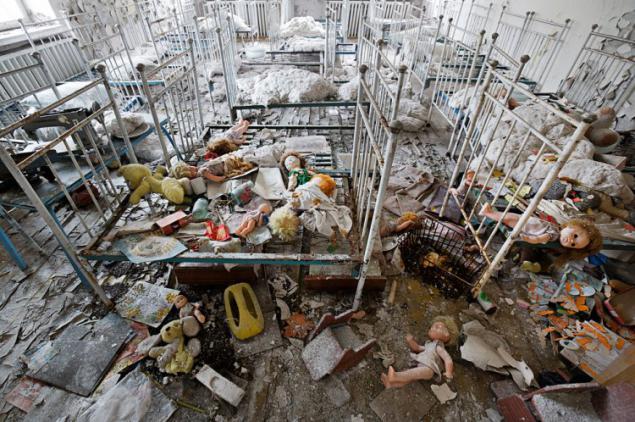
The wind blows in an abandoned city. April 26, 1986, this amusement park preparing to celebrate May 1, when less than 3 km from the exploded reactor №4. In the photo: Chernobyl, 1993. (Gerd Ludwig / INSTITUTE)
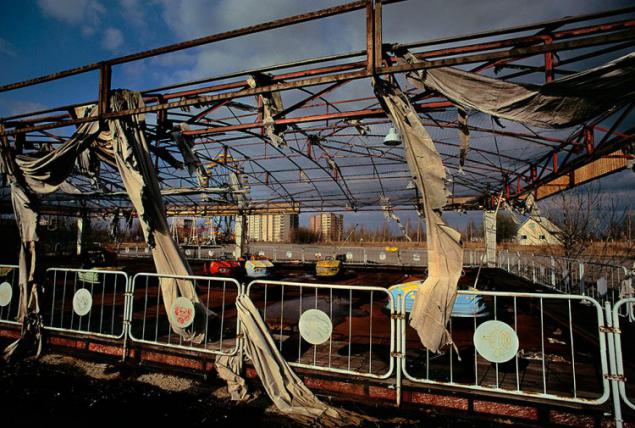
After 25 years, the park has become a symbol of desolation entertainment in the city of Pripyat. Now it is a lure for tourists who are becoming more and more. (Gerd Ludwig / INSTITUTE)
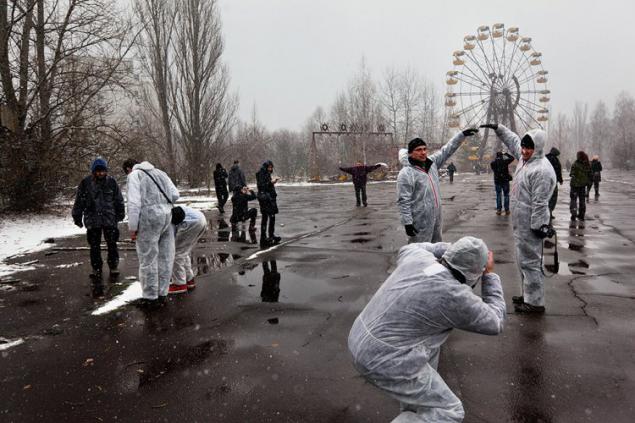
In 2011, the Ukrainian government allowed tourism in the restricted area. In Pripyat visitors roam the cluttered corridors and empty classrooms. Hundreds of abandoned gas masks strewn floor dining room. One of the tourists brought his mask - not in order to protect - to be photographed. 2011. (Gerd Ludwig / INSTITUTE)
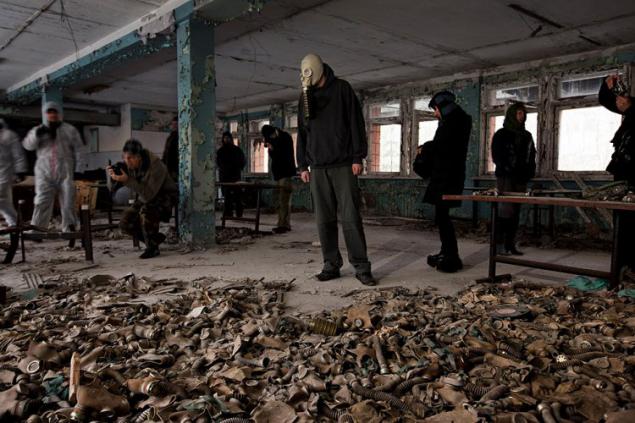
The disaster has caused contamination of thousands of square kilometers of land, forcing 150,000 people within a radius of 30 km from their homes. Today, almost all houses within a radius of abandoned polluted area, and the nature slowly begins to master them. 2005. (Gerd Ludwig / INSTITUTE)
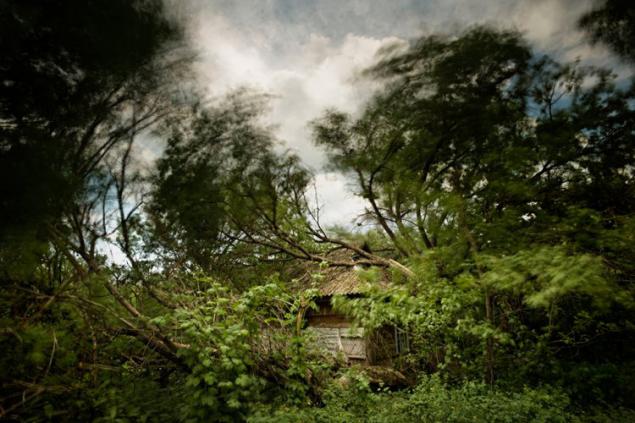
92-year-old Decani Carnitine - one of several hundred elderly people who returned to their homes in the restricted area. She prefers to die on their land, even if surrounded by desolation and ruin. 2011. (Gerd Ludwig / INSTITUTE)
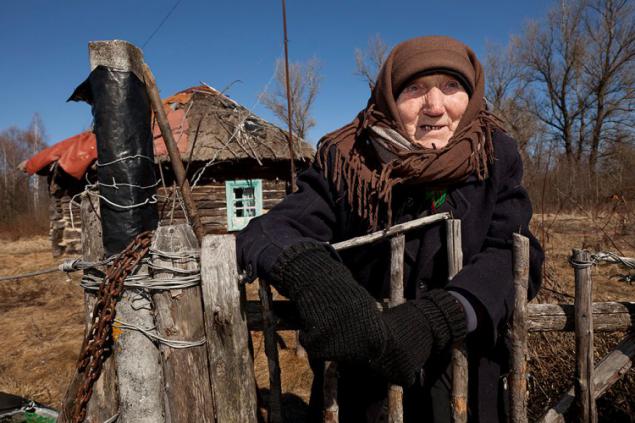
Homemade tomatoes in the sink at home deaf couple 77-year-old Ivan Martynenko and 82-year-old gapi Semenenko. After the evacuation of several hundred elderly people gradually returned to their homes, managing to grow in contaminated ground vegetables. 2005. (Gerd Ludwig / INSTITUTE)
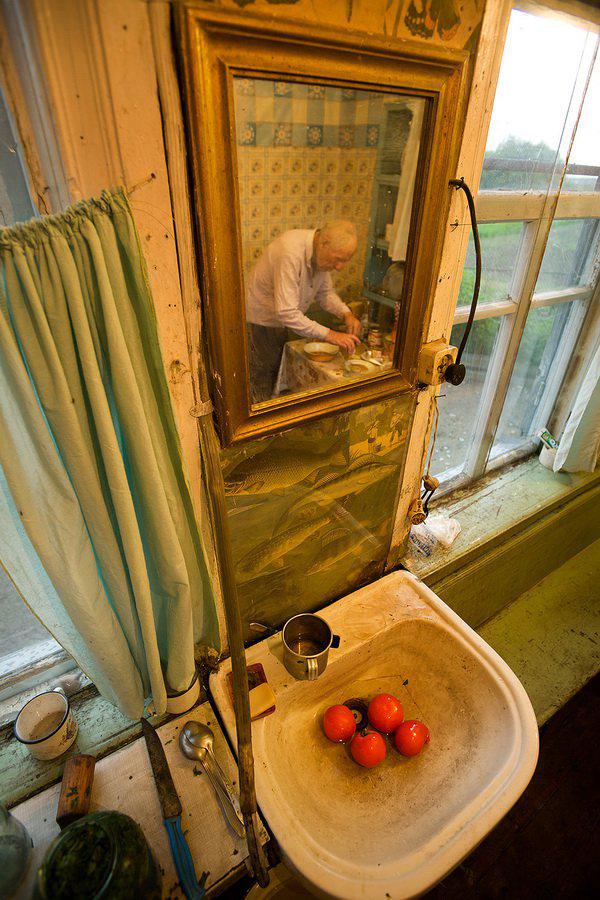
54-year-old Oleg Shapiro and 13-year-old Dima Bogdanovich suffer from thyroid cancer. In the photo they are in the hospital of Minsk. Oleg worked as a liquidator, so got a large dose of radiation. He has already overcome three operations on the thyroid gland. Dima's mother claims that her son's illness to blame the disaster at Chernobyl, but doctors are not in a hurry to draw conclusions. 2005. (Gerd Ludwig / INSTITUTE)

16-year-old Dima Pico gets help in the treatment of lymphoma in the Forest near Minsk. The Centre of Oncology Hematology built on funding from Austria after the Chernobyl disaster. 2005. (Gerd Ludwig / INSTITUTE)
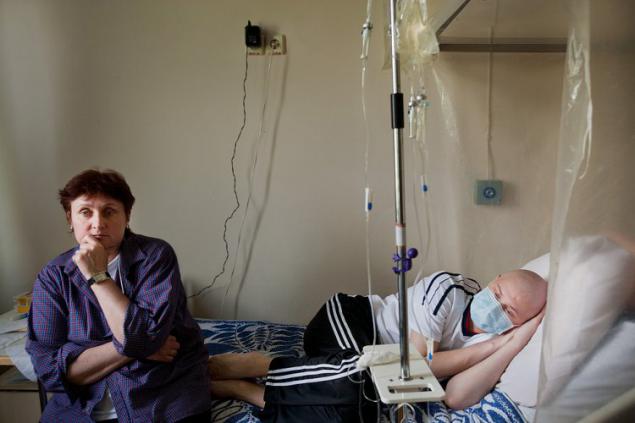
5-year-old Igor with severe disabilities abandoned by their parents, and now he lives in a children's ward of a psychiatric hospital, where a 150 orphaned and abandoned children with disabilities. This is just one of such institutions in Belarus, which supports the organization of international children of Chernobyl. 2005. (Gerd Ludwig / INSTITUTE)
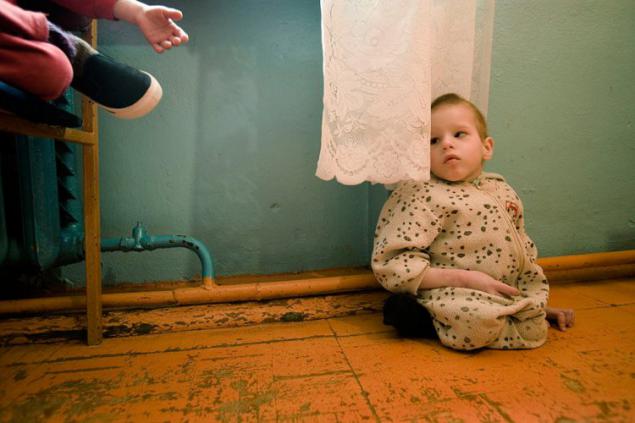
Over the next days, weeks and months after the disaster suffered radiation strong winds in the north-west, to the Belarus Gomel region, contaminating thousands of square kilometers of radioactive fallout. Today the girls were born then, give birth themselves. Many are worried about radiation and its possible consequences. 2005. (Gerd Ludwig / INSTITUTE)
Cheronike Chechet only 5 years old, and she was suffering from leukemia. Her mother - 29-year-old Elena Medeeva was born 4 years before the Chernobyl disaster in nearby Chernigov, which reached the fallout. According to local doctors, many patients - a direct result of radiation. 2011. (Gerd Ludwig / INSTITUTE)
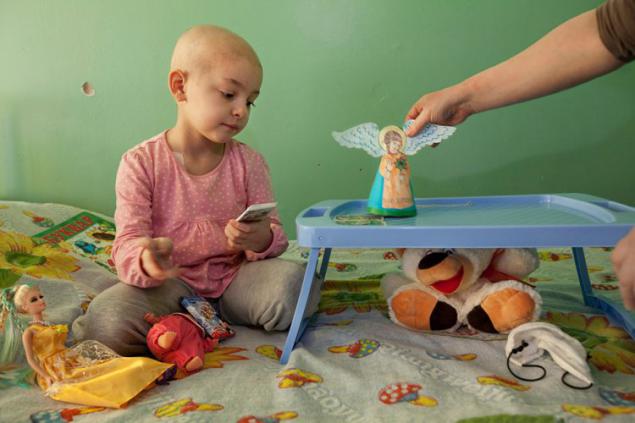
Mentally retarded boys in the Belarusian orphanage. Children born in the region of fallout, different levels of birth defects above, it is believed by many, though not all. International humanitarian organizations that emerged after the disaster continue to help shelters and orphanages in Belarus. 2005. (Gerd Ludwig / INSTITUTE)

Every year on April 26 at the Monument in honor of the firefighters of Chernobyl workers who died in the explosion, spend the evening service. The explosion of two workers died on the spot, and another 28 workers and firefighters soon died of radiation poisoning. Thousands more have died since then because of cancer. 2005. (Gerd Ludwig / INSTITUTE)
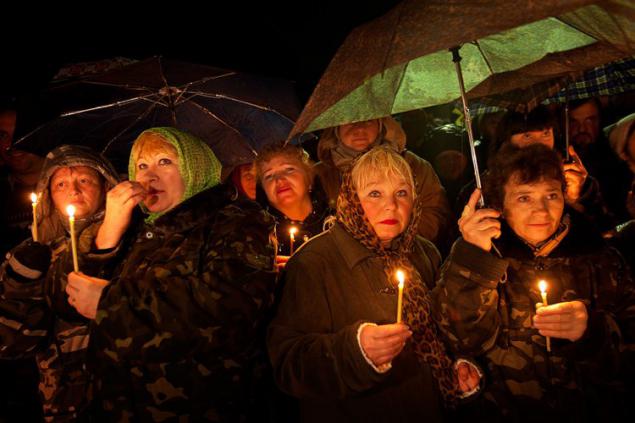
A few days after the explosion of the 4th reactor. Military helicopter sprays a decontaminating agent over the area around the Chernobyl nuclear power plant. (Photo by Getty Images | STF)
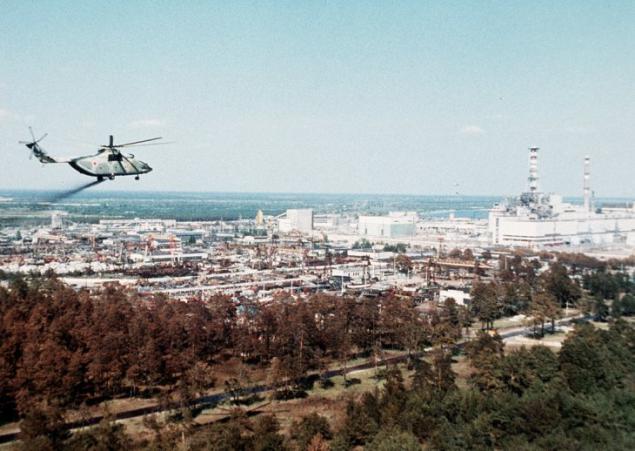
After 5 years. A photo taken Oct. 13, 1991, shows a part of the collapsed roof in a fire at the Chernobyl nuclear power plant. (Photo Efrm Lucasky | AP)

May 1986-th, a few days after the explosion. Aerial view of the Chernobyl nuclear power plant. Before the pipe is visible destroyed 4th reactor. Immediately behind the tube is the third reactor nuclear power plant that was stopped only 6 December 2000. (Photo by Getty Images | STF):
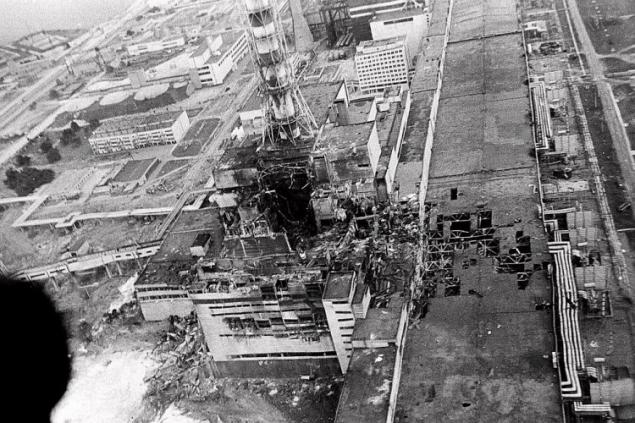
October 1, 1986. At the Chernobyl nuclear power plant are the restoration work. According to official statistics from the accident in varying degrees, affected 3,235,984 Ukrainians. In addition, the radioactive cloud spread across Europe. (Photo Zufakov | AFP):
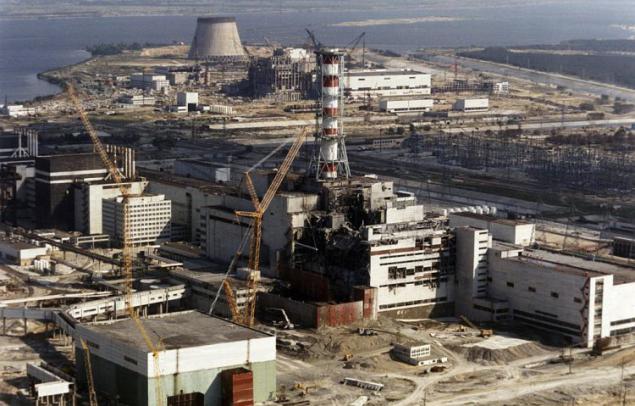
Fire, Major-General Leonid Telyatnikov. He took part in extinguishing the fire in the first hours after the accident at the Chernobyl nuclear power plant April 26, 1986. Extinguishing received a high dose of radiation, and was hospitalized for two months. The only member of the fire service of the republic, in peacetime award the honorary title of Hero of the Soviet Union. (Photo by Reuters):
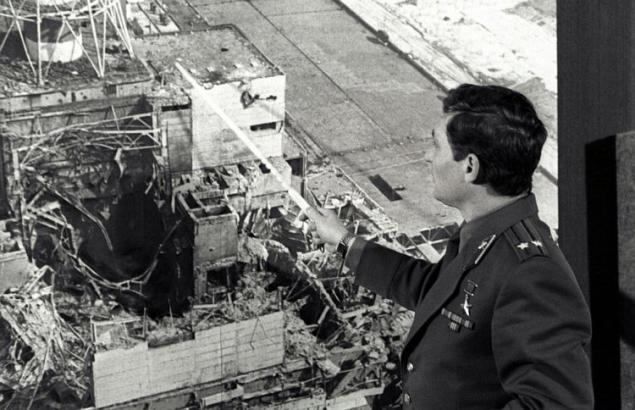
August 5, 1986. At the Chernobyl nuclear power plant are the restoration work. (Photo Zufakov | AFP):
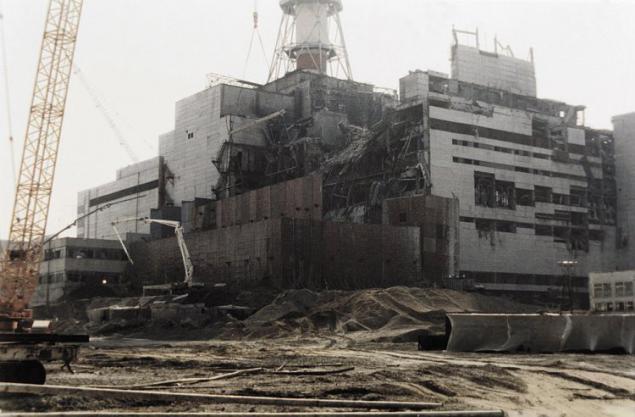
The photograph of the Institute of Atomic Energy. Kurchatov checks the level of radiation, June 5, 1986. (Photo by Mikhail Metzel | AP):
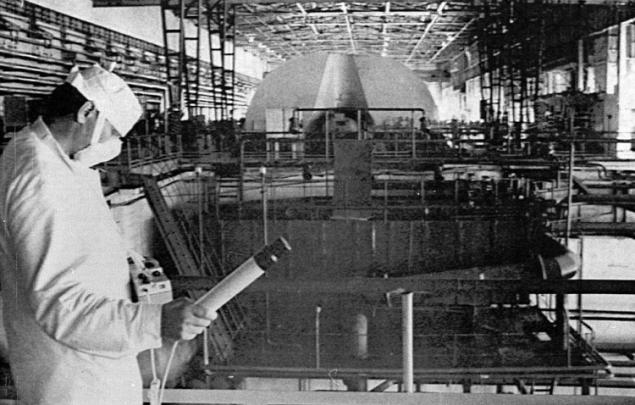
November 10, 2000. This cemetery for vehicles contaminated by radiation. About 1 350 military helicopters, buses, bulldozers, fire trucks and ambulances were used to combat the effects of the accident 26 April 1986 at the Chernobyl Nuclear Power Plant. (Photo Efrem Lukatsky | AP):
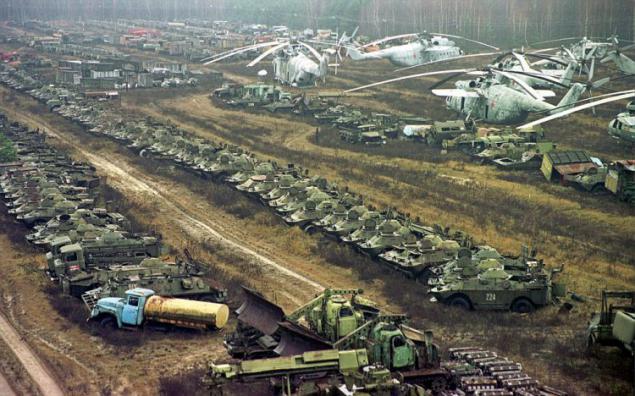
Operator room of the destroyed 4th reactor of the Chernobyl nuclear power plant, which is located inside the concrete "sarcophagus" over it destroyed unit. (Photo by Mikhail Metzel | AP):
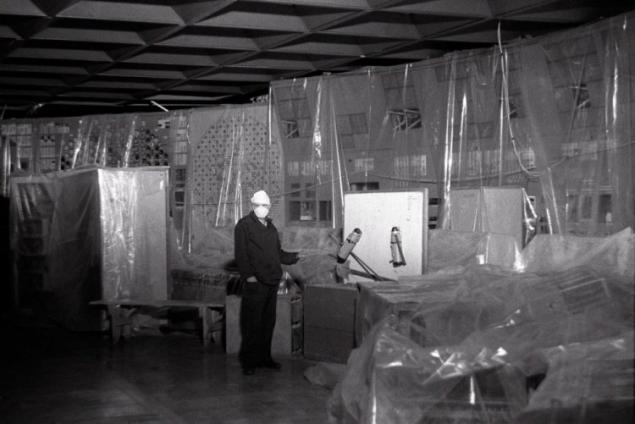
May 1986, Children's Hospital in Warsaw. Prophylaxis against possible infection due to the radioactive cloud that spread across Europe. (Photo Czarek Sokolowski | AP):
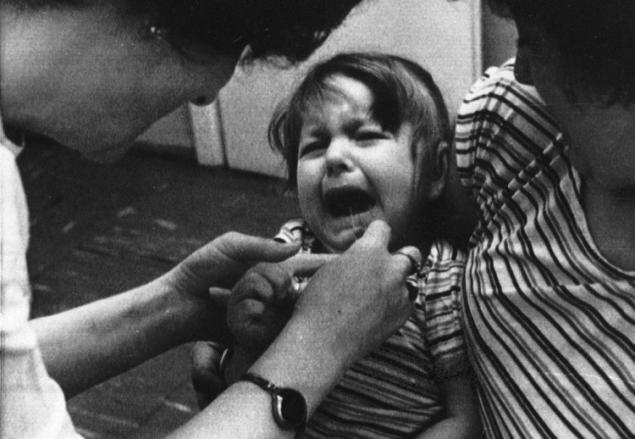
October 1986. Trucks with cement at the construction site to create a "sarcophagus" exploded over the 4th reactor of the Chernobyl nuclear power plant. (Photo by Reuters):
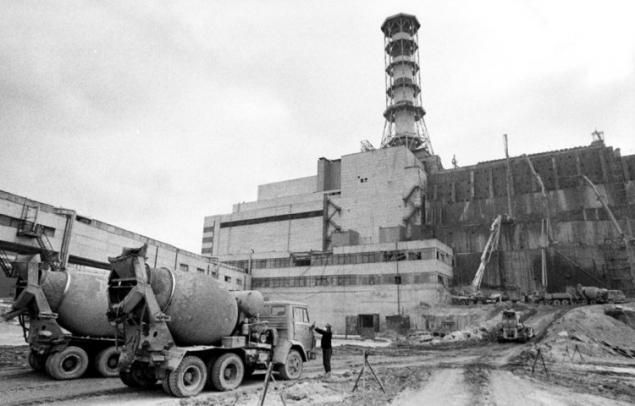
March 11, 1996, the city of Zhytomyr. Member of the Ukrainian Academy of Sciences Vyacheslav Konovalov shows mutated foal. He studied biological mutations that emerged after the Chernobyl accident. (Photo Efrem Lukatsky | AP):

Monument to Lenin in a small park at the port of Chernobyl. This port was abandoned shortly after the 1986 accident. (Photo by Daniel Berehulak | Getty Images):
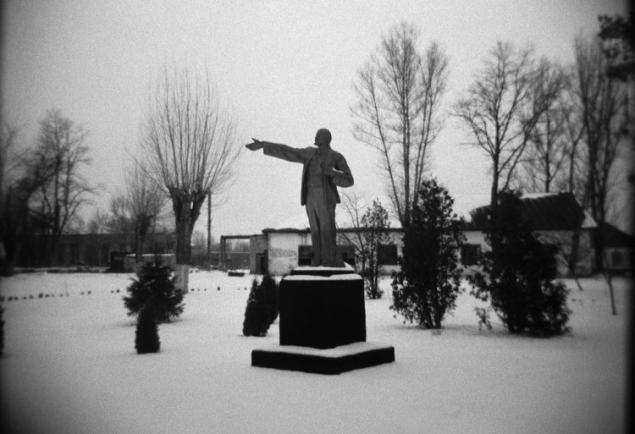
20 years later. View of the Chernobyl nuclear power plant April 26, 2006. (Photo by Mykola Lazarenko | Reuters):
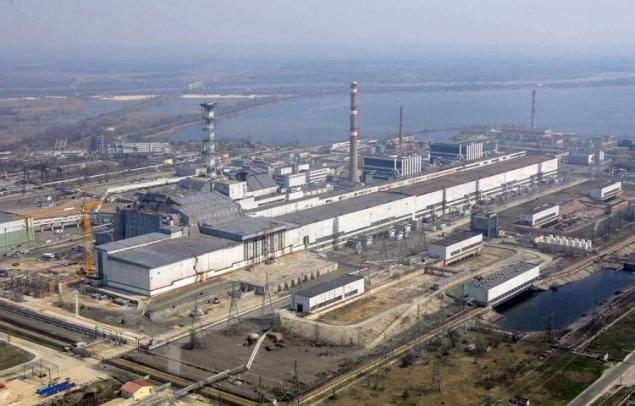
April 3, 2006. Lesson of civil defense in the school, located in the immediate vicinity of the Chernobyl contamination zone. (Photo by Oded Balilty | AP):
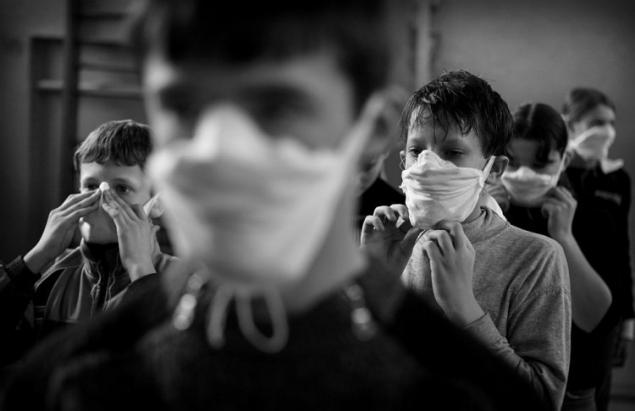
April 13, 2006. View of the Chernobyl nuclear power plant from the ghost town of Pripyat - abandoned Ukrainian city on the banks of the same river, 3 km from the nuclear power plant. (Photo by Gleb Garanich | Reuters):
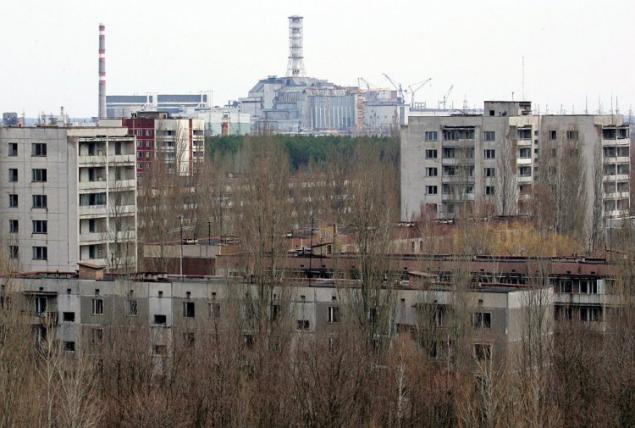
April 13, 2006. Abandoned ferris wheel in an abandoned ghost town of Pripyat. (Photo by Gleb Garanich | Reuters):
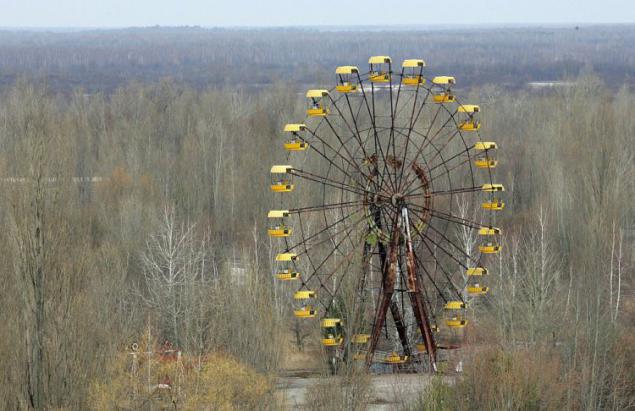
April 2, 2006. Children's beds in the hospital town of Pripyat, which was completely evacuated for several days after the accident at the Chernobyl nuclear power plant. (Photo by Oded Balilty | AP):
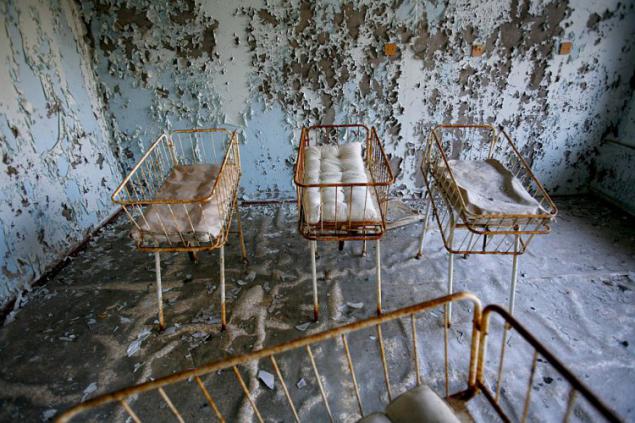
General view of the ghost town of Pripyat, April 13, 2006. (Photo by Gleb Garanich | Reuters):

September 16, 2010. Photo on the background of the concrete "sarcophagus". Thousands of people each year visit the Chernobyl nuclear power plant - a place where there was the largest of its kind in the accident in the history of nuclear power. And by the way, a Geiger counter shows the excess radiation levels 37 times. (Photo by Genya Savilov | AFP):

A lone passerby with a dog in the street of the city of Chernobyl, 13 April 2006. (Photo by Gleb Garanich | Reuters):
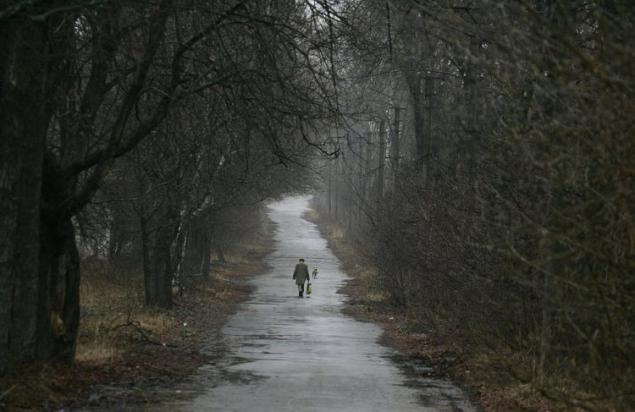
House in the deserted village Redkovka 35 km from the Chernobyl nuclear power plant on March 30, 2006. (Photo by Sergey Ponomarev | AP):
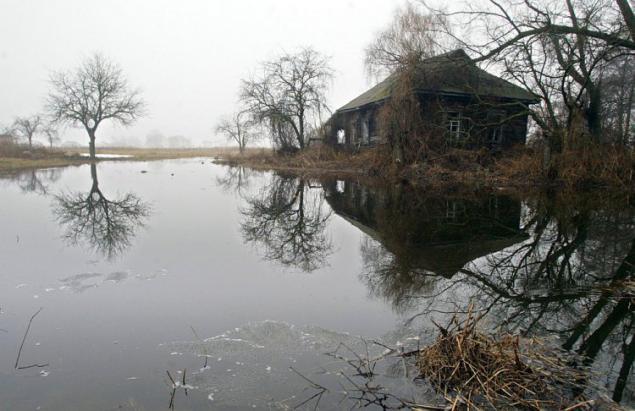
February 1, 2008. Wolf about the Belarusian village Babchin, inside the exclusion zone. After the men left the area around the Chernobyl nuclear power plant, there was a lot of wild animals, despite the radiation. (Photo by Vasily Fedosenko | Reuters):

April 25, 2009. Monument to the Victims of Chernobyl, Slavutych city, 50 kilometers from the crash site. (Photo by Sergei Supinsky | AFP):
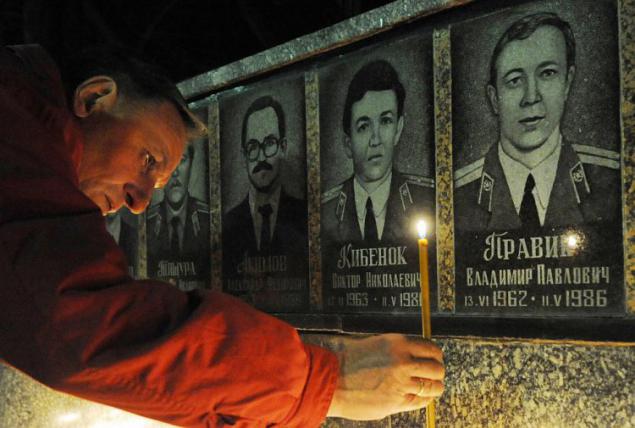
April 18, 2006. Exhibition at the Museum "Chernobyl" in Kiev. These are photos of the people who worked at the Chernobyl nuclear power plant immediately after the explosion in April 1986. (Photo by Gleb Garanich | Reuters):
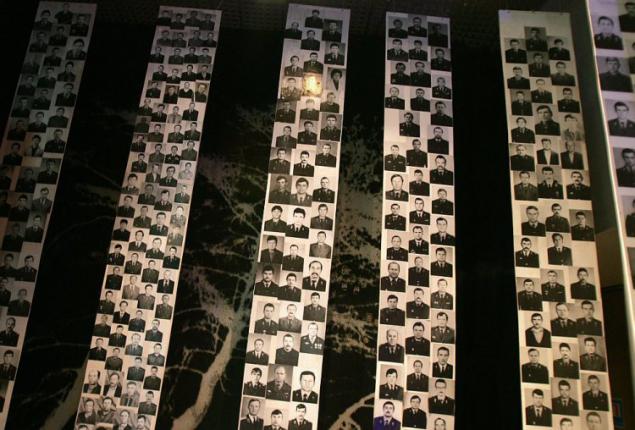
May 10, 2007. The same exploded 4th reactor of the Chernobyl nuclear power plant under the concrete "sarcophagus". From left to see the monument, which was opened in 2006. (Photo Efrem Lukatsky | AP):
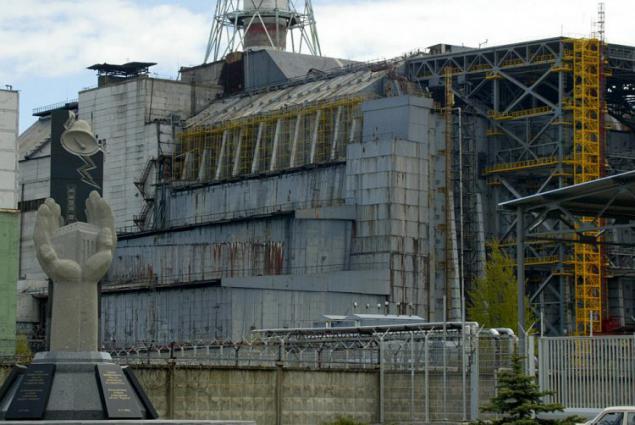
April 1996. With the help of the drilling machine being tested concrete "sarcophagus" around the Chernobyl reactor exploded. (Photo by Reuters):
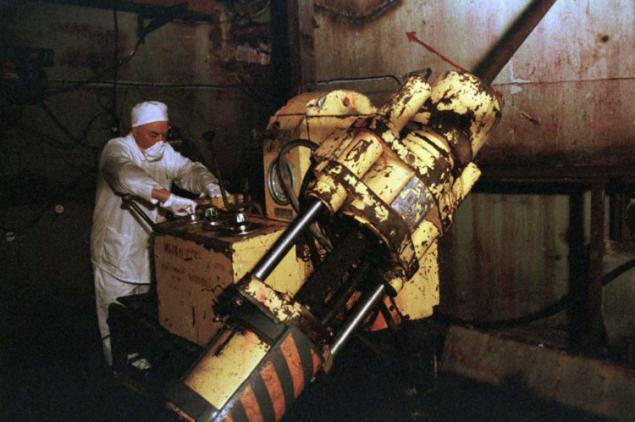
November 16, 2010. Former control point 4th reactor of the Chernobyl nuclear power plant. Geiger shows are about 80, 000 micro-roentgen per hour, which is 16 000 times greater than the maximum permissible value. (Photo Efrem Lukatsky | AP):
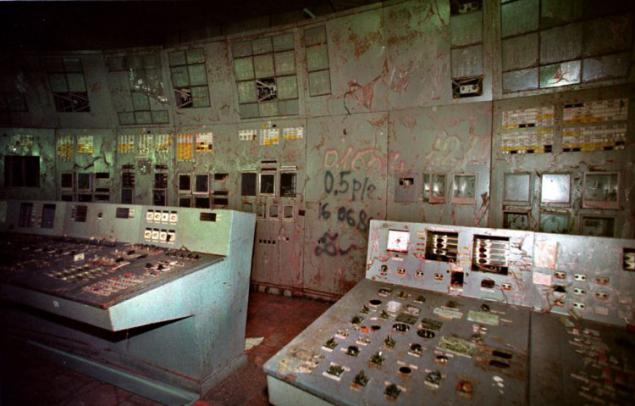
Employee inside the Chernobyl nuclear power plant control room of the 4th reactor, February 24, 2011. (Photo by Sergei Supinsky | AFP):

Again deserted ghost town of Pripyat, located 3 km from the nuclear power plant, February 22, 2011. (Photo by Sergei Supinsky | AFP):

Inside one of the buildings in the city of Pripyat, February 24, 2011. (Photo by Gleb Garanich | Reuters):
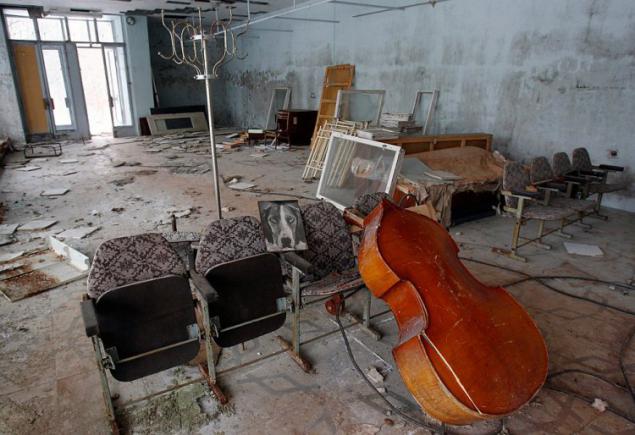
This man came to see her former home, located in the exclusion zone around the Chernobyl nuclear power plant, from which all were evacuated, March 18, 2011. (Photo by Vasily Fedosenko | Reuters):
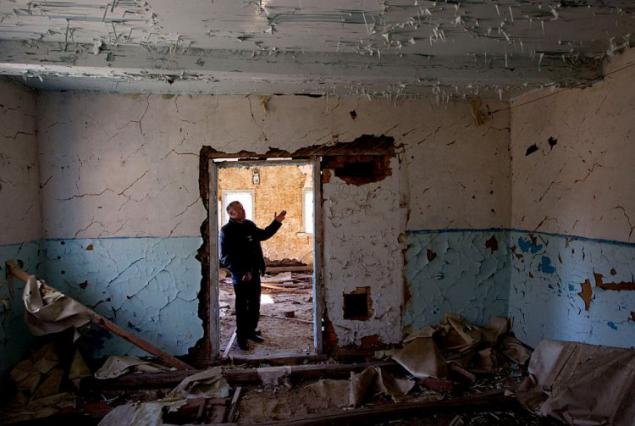
9-year-old girl born with disabilities. He currently lives in the village Straholese, located not far from the exclusion zone around the Chernobyl nuclear power plant closed. (Photo by Damir Sagolj | Reuters):
Vladivostok, March 16, 2011. The scoreboard displays not only time and temperature, but also the level of nuclear activity. (Photo by Yuri Maltsev | Reuters):
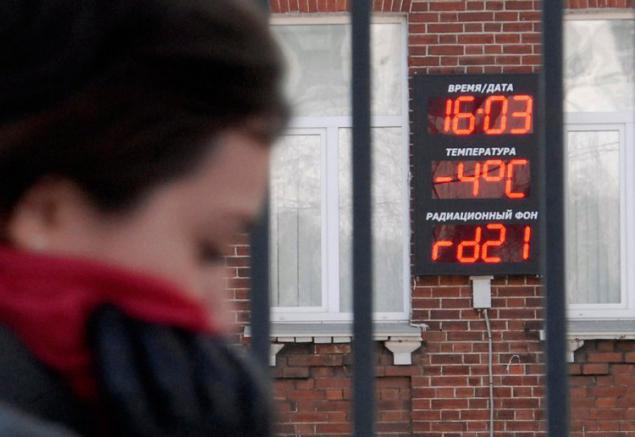
8-year-old Ukrainian girl with cancer, is in hospital in Kiev. The report for the year 2006 the organization "Greenpeace" gave their forecasts that more than 90 000 people die of cancer caused by radiation from the Chernobyl nuclear power plant. These data differ from the forecast of the United Nations predicts that about 4,000 deaths. This once again highlights how difficult to determine the extent of the effect of radiation on human health. (Photo by Oded Balilty | AP):
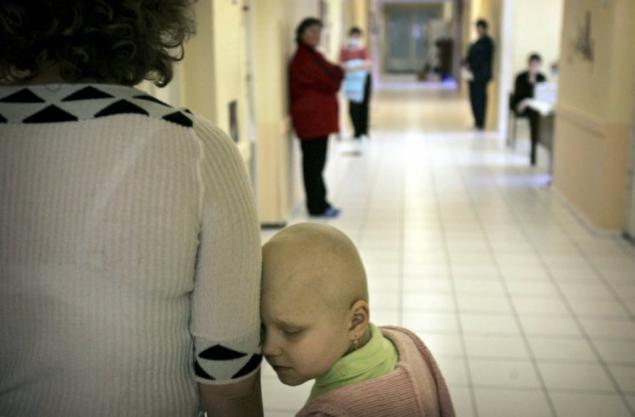
Photos from the February issue of the magazine "Soviet life": the main hall of the 1st unit of the Chernobyl nuclear power plant April 29, 1986 in Chernobyl (Ukraine). The Soviet Union recognized that the power plant accident occurred, but did not provide further details. (AP Photo)

Swedish farmer removes sediments contaminated by radiation straw a few months after the explosion at the Chernobyl nuclear power plant in June 1986. (STF / AFP / Getty Images)
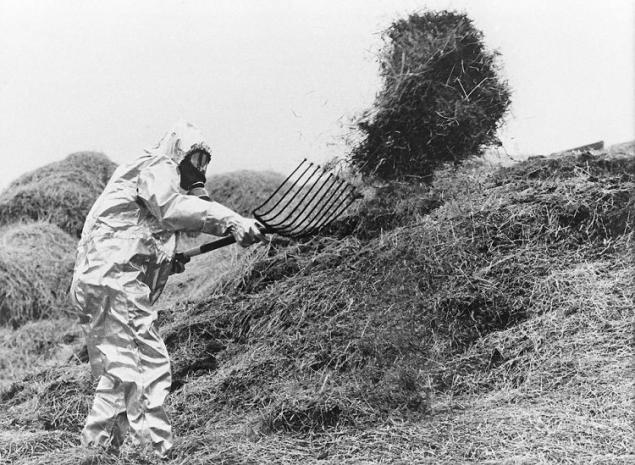
Soviet medical worker inspects an unknown child who had been evacuated from the area of the nuclear disaster at the farm "Kopelovo" near Kiev, May 11, 1986. The picture was taken during a trip organized by the Soviet authorities in order to show how they cope with the accident. (AP Photo / Boris Yurchenko)
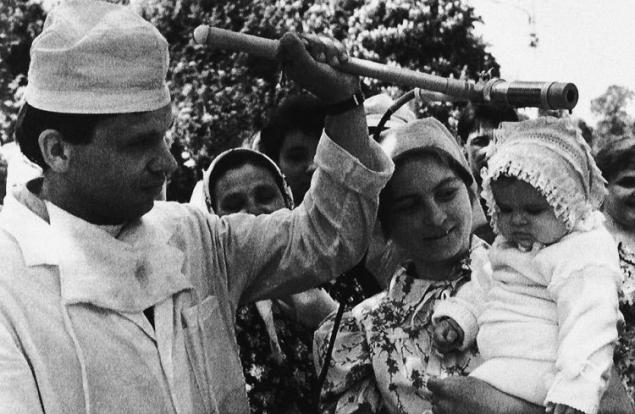
Chairman of the Presidium of the Supreme Soviet of the USSR Mikhail Gorbachev (center) and his wife Raisa Gorbachev during a meeting with the leadership of the NPP February 23, 1989. It was the first visit to the Soviet leader at the station after the accident, which occurred in April 1986. (AFP PHOTO / TASS)
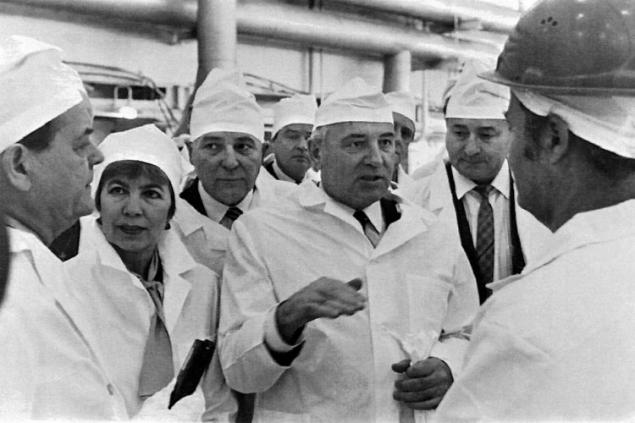
The people of Kiev are in the queue for forms to check for infection by radiation after the Chernobyl disaster in Kiev, May 9, 1986. (AP Photo / Boris Yurchenko)
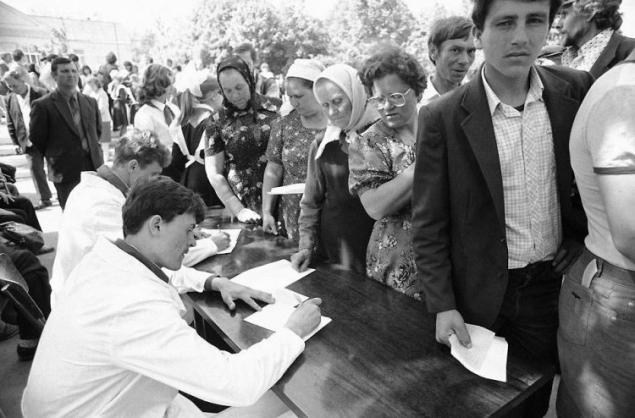
The boy reads the ad at the closed gate of the playground in Wiesbaden May 5, 1986, which says: "This area is temporarily closed." A week later, the explosion of the nuclear reactor in Chernobyl April 26, 1986 the municipal council of Wiesbaden closed all playgrounds after the discovery of radioactivity levels from 124 to 280 becquerels. (AP Photo / Frank Rumpenhorst)

One of the engineers who worked at the Chernobyl NPP, undergoes a medical examination at the sanatorium "Forest Glade" May 15, 1986, a few weeks after the explosion. (STF / AFP / Getty Images)

Activists of environmental mark railcars, which is contaminated by radiation whey. Picture taken in Bremen, in northern Germany February 6, 1987. Serum, which was delivered to Bremen for onward transport to Egypt, was made after the Chernobyl accident, and has been contaminated by radioactive fallout. (AP Photo / Peter Meyer)
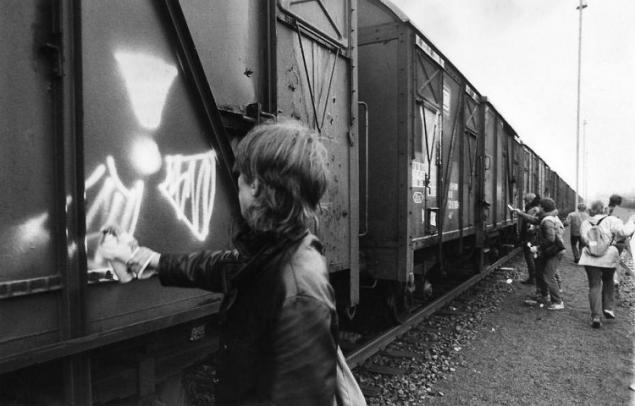
Slaughterhouse worker is stamped on the suitability for cow carcasses in Frankfurt, West Germany, May 12, 1986. According to the decision of the Minister of Social Affairs of the federal state of Hesse, after the explosion of the Chernobyl all the meat was exposed to the radiation monitoring. (AP Photo / Kurt Strumpf / stf)
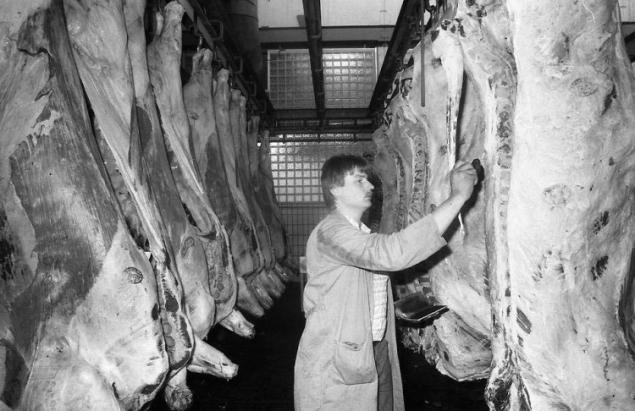
Archival photo from April 14, 1998. Chernobyl Nuclear Power Plant workers pass by the control panel of the destroyed 4th power unit. April 26, 2006 Ukraine celebrated the 20th anniversary of the Chernobyl disaster, touching the fate of millions of people, it took the astronomical costs of international funds and has become an ominous symbol of the dangers of nuclear energy. (AFP PHOTO / GENIA SAVILOV)
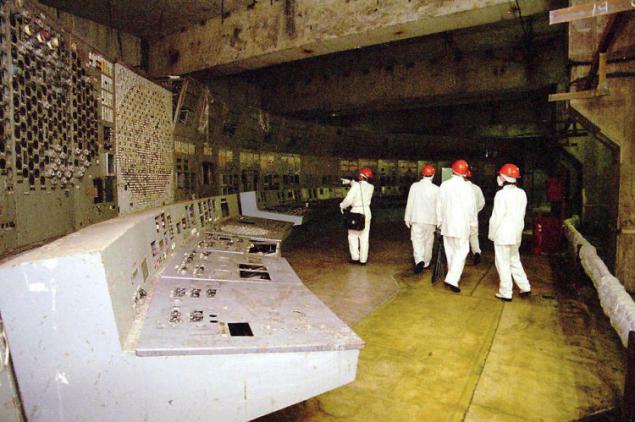
In the picture, which was issued on 14 April 1998, you can see the control panel of the 4th unit of the Chernobyl Nuclear Power Plant. (AFP PHOTO / GENIA SAVILOV)
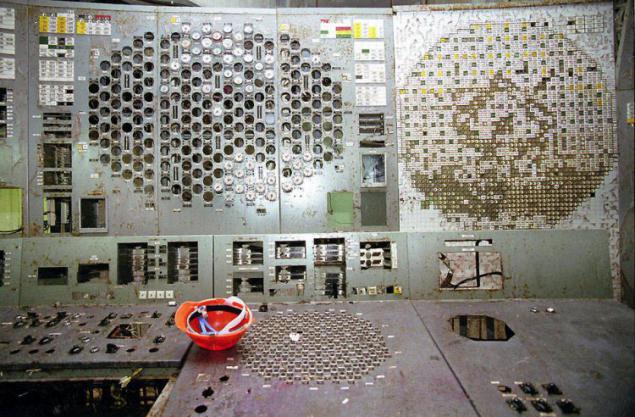
Workers who participated in the construction of a cement sarcophagus covering the Chernobyl reactor in the memorable 1986 photo next to an unfinished building. According to the "Chernobyl Union of Ukraine" thousands of people who took part in the aftermath of the Chernobyl disaster, died from the effects of radiation poisoning, which affected during operation. (AP Photo / Volodymyr Repik)
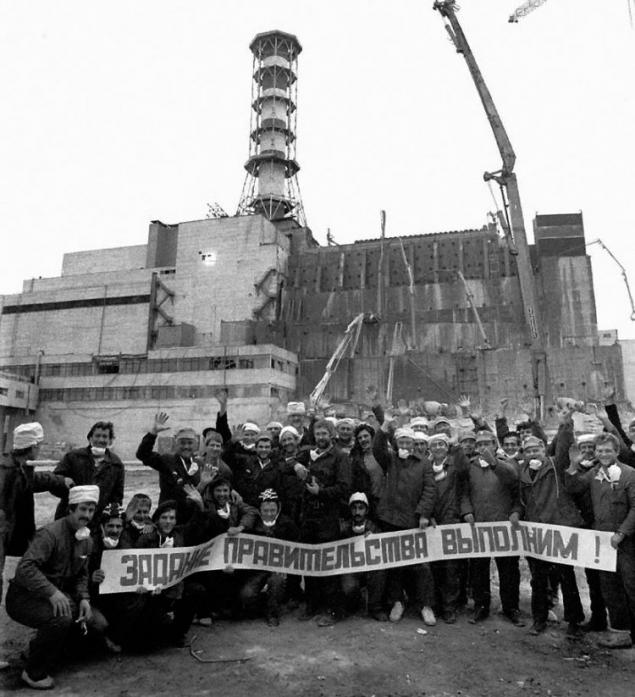
High voltage tower not far from the Chernobyl nuclear power plant June 20, 2000 in Chernobyl. (AP Photo / Efrem Lukatsky)
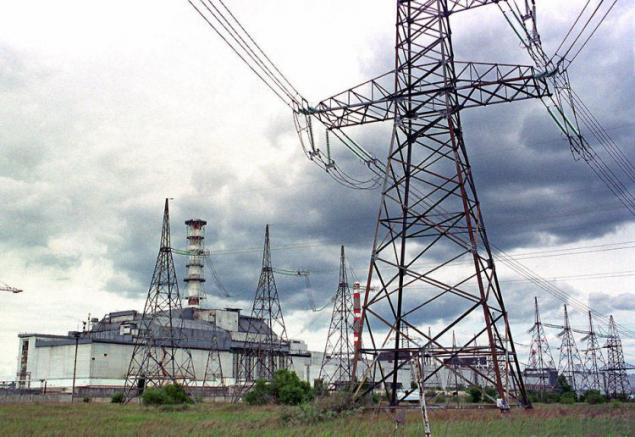
Attendant nuclear reactor control records readings on site only working reactor №3, to Tuesday, June 20, 2000.
Offers a large selection of professional journalistic photos with comments on the subject accident and its posledstviy.

April 26, 1986 the operators in this very hall №4 reactor of the Chernobyl made a series of fatal errors during testing equipment, resulting in the world's largest happened at that time technological disaster. In the photo: an abandoned room of the 4th reactor of Chernobyl, 2005. (Gerd Ludwig / INSTITUTE)

Workers in gas masks and respirators are going to drill holes for the support elements. This is a very dangerous job: the radiation level is so high that they constantly have to monitor the Geiger counters and dosimeters, and to be in this place it can be only 15 minutes a day. Chernobyl in 2005. (Gerd Ludwig / INSTITUTE)

For years, people made desperate attempts to secure the roof seekers to not collapsed. In the dimly lit tunnels sarcophagus lead to terrible rooms, full of cables, metal and other materials. Walls collapsed and debris covered the radiation dust. Work on the stabilization of completed and today inside the reactor deserted and very high levels of radiation. He is waiting for dismantling. Chernobyl in 2011. (Gerd Ludwig / INSTITUTE)

Although the level of radiation is not allowing you to stay longer than a few minutes, the workers have to overcome dangerous stairs to get to the molten core. For faster descent are built just such a "slanted ladder." (Gerd Ludwig / INSTITUTE)

Working near the nuclear power plant are exposed to dangerous levels of radiation. They are building a new Chernobyl sarcophagus worth 2, $ 2 billion. Arcuate metal structure weighing 29,000 tons height of 105 m and a width of 257 m will be built over the existing building to be able to demolish the old sarcophagus. To make a very strong foundation of a new sarcophagus in the ground 25 meters hammered 396 huge metal pipe. 2011. (Gerd Ludwig / INSTITUTE)

View from the roof of the hotel "Polesie" in the center of Pripyat. Once lived in Pripyat 50,000 people, and it is now - a ghost town, overgrown with lush vegetation. (Gerd Ludwig / INSTITUTE)

Built in 1970 for scientists and workers of the Chernobyl Nuclear Power Plant Pripyat is less than 3 km from the reactor. Once upon a time there lived 50,000 people. Authorities did not immediately warned residents about the disaster and began evacuating only 36 hours after the explosion. The picture in 1993. (Gerd Ludwig / INSTITUTE

When the authorities finally ordered to evacuate, many simply do not have time to pack. The Soviet Union announced the crash just three days after the explosion, when the nuclear cloud reached Sweden. Photo: Opachichi village in the Exclusion Zone, 1993. (Gerd Ludwig / INSTITUTE)

19 years after the disaster empty schools and kindergartens in Pripyat remain silent reminder of the sudden tragedy. This part of a school collapsed due to dilapidated. 2005. (Gerd Ludwig / INSTITUTE)

On the day of the disaster unsuspecting children playing in the room. The next day they were evacuated, and they had to leave everything, even the favorite dolls and toys. 2005. (Gerd Ludwig / INSTITUTE)

The wind blows in an abandoned city. April 26, 1986, this amusement park preparing to celebrate May 1, when less than 3 km from the exploded reactor №4. In the photo: Chernobyl, 1993. (Gerd Ludwig / INSTITUTE)

After 25 years, the park has become a symbol of desolation entertainment in the city of Pripyat. Now it is a lure for tourists who are becoming more and more. (Gerd Ludwig / INSTITUTE)

In 2011, the Ukrainian government allowed tourism in the restricted area. In Pripyat visitors roam the cluttered corridors and empty classrooms. Hundreds of abandoned gas masks strewn floor dining room. One of the tourists brought his mask - not in order to protect - to be photographed. 2011. (Gerd Ludwig / INSTITUTE)

The disaster has caused contamination of thousands of square kilometers of land, forcing 150,000 people within a radius of 30 km from their homes. Today, almost all houses within a radius of abandoned polluted area, and the nature slowly begins to master them. 2005. (Gerd Ludwig / INSTITUTE)

92-year-old Decani Carnitine - one of several hundred elderly people who returned to their homes in the restricted area. She prefers to die on their land, even if surrounded by desolation and ruin. 2011. (Gerd Ludwig / INSTITUTE)

Homemade tomatoes in the sink at home deaf couple 77-year-old Ivan Martynenko and 82-year-old gapi Semenenko. After the evacuation of several hundred elderly people gradually returned to their homes, managing to grow in contaminated ground vegetables. 2005. (Gerd Ludwig / INSTITUTE)

54-year-old Oleg Shapiro and 13-year-old Dima Bogdanovich suffer from thyroid cancer. In the photo they are in the hospital of Minsk. Oleg worked as a liquidator, so got a large dose of radiation. He has already overcome three operations on the thyroid gland. Dima's mother claims that her son's illness to blame the disaster at Chernobyl, but doctors are not in a hurry to draw conclusions. 2005. (Gerd Ludwig / INSTITUTE)

16-year-old Dima Pico gets help in the treatment of lymphoma in the Forest near Minsk. The Centre of Oncology Hematology built on funding from Austria after the Chernobyl disaster. 2005. (Gerd Ludwig / INSTITUTE)

5-year-old Igor with severe disabilities abandoned by their parents, and now he lives in a children's ward of a psychiatric hospital, where a 150 orphaned and abandoned children with disabilities. This is just one of such institutions in Belarus, which supports the organization of international children of Chernobyl. 2005. (Gerd Ludwig / INSTITUTE)

Over the next days, weeks and months after the disaster suffered radiation strong winds in the north-west, to the Belarus Gomel region, contaminating thousands of square kilometers of radioactive fallout. Today the girls were born then, give birth themselves. Many are worried about radiation and its possible consequences. 2005. (Gerd Ludwig / INSTITUTE)
Cheronike Chechet only 5 years old, and she was suffering from leukemia. Her mother - 29-year-old Elena Medeeva was born 4 years before the Chernobyl disaster in nearby Chernigov, which reached the fallout. According to local doctors, many patients - a direct result of radiation. 2011. (Gerd Ludwig / INSTITUTE)

Mentally retarded boys in the Belarusian orphanage. Children born in the region of fallout, different levels of birth defects above, it is believed by many, though not all. International humanitarian organizations that emerged after the disaster continue to help shelters and orphanages in Belarus. 2005. (Gerd Ludwig / INSTITUTE)

Every year on April 26 at the Monument in honor of the firefighters of Chernobyl workers who died in the explosion, spend the evening service. The explosion of two workers died on the spot, and another 28 workers and firefighters soon died of radiation poisoning. Thousands more have died since then because of cancer. 2005. (Gerd Ludwig / INSTITUTE)

A few days after the explosion of the 4th reactor. Military helicopter sprays a decontaminating agent over the area around the Chernobyl nuclear power plant. (Photo by Getty Images | STF)

After 5 years. A photo taken Oct. 13, 1991, shows a part of the collapsed roof in a fire at the Chernobyl nuclear power plant. (Photo Efrm Lucasky | AP)

May 1986-th, a few days after the explosion. Aerial view of the Chernobyl nuclear power plant. Before the pipe is visible destroyed 4th reactor. Immediately behind the tube is the third reactor nuclear power plant that was stopped only 6 December 2000. (Photo by Getty Images | STF):

October 1, 1986. At the Chernobyl nuclear power plant are the restoration work. According to official statistics from the accident in varying degrees, affected 3,235,984 Ukrainians. In addition, the radioactive cloud spread across Europe. (Photo Zufakov | AFP):

Fire, Major-General Leonid Telyatnikov. He took part in extinguishing the fire in the first hours after the accident at the Chernobyl nuclear power plant April 26, 1986. Extinguishing received a high dose of radiation, and was hospitalized for two months. The only member of the fire service of the republic, in peacetime award the honorary title of Hero of the Soviet Union. (Photo by Reuters):

August 5, 1986. At the Chernobyl nuclear power plant are the restoration work. (Photo Zufakov | AFP):

The photograph of the Institute of Atomic Energy. Kurchatov checks the level of radiation, June 5, 1986. (Photo by Mikhail Metzel | AP):

November 10, 2000. This cemetery for vehicles contaminated by radiation. About 1 350 military helicopters, buses, bulldozers, fire trucks and ambulances were used to combat the effects of the accident 26 April 1986 at the Chernobyl Nuclear Power Plant. (Photo Efrem Lukatsky | AP):

Operator room of the destroyed 4th reactor of the Chernobyl nuclear power plant, which is located inside the concrete "sarcophagus" over it destroyed unit. (Photo by Mikhail Metzel | AP):

May 1986, Children's Hospital in Warsaw. Prophylaxis against possible infection due to the radioactive cloud that spread across Europe. (Photo Czarek Sokolowski | AP):

October 1986. Trucks with cement at the construction site to create a "sarcophagus" exploded over the 4th reactor of the Chernobyl nuclear power plant. (Photo by Reuters):

March 11, 1996, the city of Zhytomyr. Member of the Ukrainian Academy of Sciences Vyacheslav Konovalov shows mutated foal. He studied biological mutations that emerged after the Chernobyl accident. (Photo Efrem Lukatsky | AP):

Monument to Lenin in a small park at the port of Chernobyl. This port was abandoned shortly after the 1986 accident. (Photo by Daniel Berehulak | Getty Images):

20 years later. View of the Chernobyl nuclear power plant April 26, 2006. (Photo by Mykola Lazarenko | Reuters):

April 3, 2006. Lesson of civil defense in the school, located in the immediate vicinity of the Chernobyl contamination zone. (Photo by Oded Balilty | AP):

April 13, 2006. View of the Chernobyl nuclear power plant from the ghost town of Pripyat - abandoned Ukrainian city on the banks of the same river, 3 km from the nuclear power plant. (Photo by Gleb Garanich | Reuters):

April 13, 2006. Abandoned ferris wheel in an abandoned ghost town of Pripyat. (Photo by Gleb Garanich | Reuters):

April 2, 2006. Children's beds in the hospital town of Pripyat, which was completely evacuated for several days after the accident at the Chernobyl nuclear power plant. (Photo by Oded Balilty | AP):

General view of the ghost town of Pripyat, April 13, 2006. (Photo by Gleb Garanich | Reuters):

September 16, 2010. Photo on the background of the concrete "sarcophagus". Thousands of people each year visit the Chernobyl nuclear power plant - a place where there was the largest of its kind in the accident in the history of nuclear power. And by the way, a Geiger counter shows the excess radiation levels 37 times. (Photo by Genya Savilov | AFP):

A lone passerby with a dog in the street of the city of Chernobyl, 13 April 2006. (Photo by Gleb Garanich | Reuters):

House in the deserted village Redkovka 35 km from the Chernobyl nuclear power plant on March 30, 2006. (Photo by Sergey Ponomarev | AP):

February 1, 2008. Wolf about the Belarusian village Babchin, inside the exclusion zone. After the men left the area around the Chernobyl nuclear power plant, there was a lot of wild animals, despite the radiation. (Photo by Vasily Fedosenko | Reuters):

April 25, 2009. Monument to the Victims of Chernobyl, Slavutych city, 50 kilometers from the crash site. (Photo by Sergei Supinsky | AFP):

April 18, 2006. Exhibition at the Museum "Chernobyl" in Kiev. These are photos of the people who worked at the Chernobyl nuclear power plant immediately after the explosion in April 1986. (Photo by Gleb Garanich | Reuters):

May 10, 2007. The same exploded 4th reactor of the Chernobyl nuclear power plant under the concrete "sarcophagus". From left to see the monument, which was opened in 2006. (Photo Efrem Lukatsky | AP):

April 1996. With the help of the drilling machine being tested concrete "sarcophagus" around the Chernobyl reactor exploded. (Photo by Reuters):

November 16, 2010. Former control point 4th reactor of the Chernobyl nuclear power plant. Geiger shows are about 80, 000 micro-roentgen per hour, which is 16 000 times greater than the maximum permissible value. (Photo Efrem Lukatsky | AP):

Employee inside the Chernobyl nuclear power plant control room of the 4th reactor, February 24, 2011. (Photo by Sergei Supinsky | AFP):

Again deserted ghost town of Pripyat, located 3 km from the nuclear power plant, February 22, 2011. (Photo by Sergei Supinsky | AFP):

Inside one of the buildings in the city of Pripyat, February 24, 2011. (Photo by Gleb Garanich | Reuters):

This man came to see her former home, located in the exclusion zone around the Chernobyl nuclear power plant, from which all were evacuated, March 18, 2011. (Photo by Vasily Fedosenko | Reuters):

9-year-old girl born with disabilities. He currently lives in the village Straholese, located not far from the exclusion zone around the Chernobyl nuclear power plant closed. (Photo by Damir Sagolj | Reuters):
Vladivostok, March 16, 2011. The scoreboard displays not only time and temperature, but also the level of nuclear activity. (Photo by Yuri Maltsev | Reuters):

8-year-old Ukrainian girl with cancer, is in hospital in Kiev. The report for the year 2006 the organization "Greenpeace" gave their forecasts that more than 90 000 people die of cancer caused by radiation from the Chernobyl nuclear power plant. These data differ from the forecast of the United Nations predicts that about 4,000 deaths. This once again highlights how difficult to determine the extent of the effect of radiation on human health. (Photo by Oded Balilty | AP):

Photos from the February issue of the magazine "Soviet life": the main hall of the 1st unit of the Chernobyl nuclear power plant April 29, 1986 in Chernobyl (Ukraine). The Soviet Union recognized that the power plant accident occurred, but did not provide further details. (AP Photo)

Swedish farmer removes sediments contaminated by radiation straw a few months after the explosion at the Chernobyl nuclear power plant in June 1986. (STF / AFP / Getty Images)

Soviet medical worker inspects an unknown child who had been evacuated from the area of the nuclear disaster at the farm "Kopelovo" near Kiev, May 11, 1986. The picture was taken during a trip organized by the Soviet authorities in order to show how they cope with the accident. (AP Photo / Boris Yurchenko)

Chairman of the Presidium of the Supreme Soviet of the USSR Mikhail Gorbachev (center) and his wife Raisa Gorbachev during a meeting with the leadership of the NPP February 23, 1989. It was the first visit to the Soviet leader at the station after the accident, which occurred in April 1986. (AFP PHOTO / TASS)

The people of Kiev are in the queue for forms to check for infection by radiation after the Chernobyl disaster in Kiev, May 9, 1986. (AP Photo / Boris Yurchenko)

The boy reads the ad at the closed gate of the playground in Wiesbaden May 5, 1986, which says: "This area is temporarily closed." A week later, the explosion of the nuclear reactor in Chernobyl April 26, 1986 the municipal council of Wiesbaden closed all playgrounds after the discovery of radioactivity levels from 124 to 280 becquerels. (AP Photo / Frank Rumpenhorst)

One of the engineers who worked at the Chernobyl NPP, undergoes a medical examination at the sanatorium "Forest Glade" May 15, 1986, a few weeks after the explosion. (STF / AFP / Getty Images)

Activists of environmental mark railcars, which is contaminated by radiation whey. Picture taken in Bremen, in northern Germany February 6, 1987. Serum, which was delivered to Bremen for onward transport to Egypt, was made after the Chernobyl accident, and has been contaminated by radioactive fallout. (AP Photo / Peter Meyer)

Slaughterhouse worker is stamped on the suitability for cow carcasses in Frankfurt, West Germany, May 12, 1986. According to the decision of the Minister of Social Affairs of the federal state of Hesse, after the explosion of the Chernobyl all the meat was exposed to the radiation monitoring. (AP Photo / Kurt Strumpf / stf)

Archival photo from April 14, 1998. Chernobyl Nuclear Power Plant workers pass by the control panel of the destroyed 4th power unit. April 26, 2006 Ukraine celebrated the 20th anniversary of the Chernobyl disaster, touching the fate of millions of people, it took the astronomical costs of international funds and has become an ominous symbol of the dangers of nuclear energy. (AFP PHOTO / GENIA SAVILOV)

In the picture, which was issued on 14 April 1998, you can see the control panel of the 4th unit of the Chernobyl Nuclear Power Plant. (AFP PHOTO / GENIA SAVILOV)

Workers who participated in the construction of a cement sarcophagus covering the Chernobyl reactor in the memorable 1986 photo next to an unfinished building. According to the "Chernobyl Union of Ukraine" thousands of people who took part in the aftermath of the Chernobyl disaster, died from the effects of radiation poisoning, which affected during operation. (AP Photo / Volodymyr Repik)

High voltage tower not far from the Chernobyl nuclear power plant June 20, 2000 in Chernobyl. (AP Photo / Efrem Lukatsky)

Attendant nuclear reactor control records readings on site only working reactor №3, to Tuesday, June 20, 2000.
